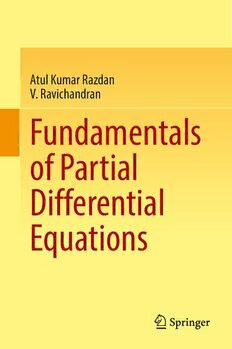Table Of ContentAtul Kumar Razdan
V. Ravichandran
Fundamentals
of Partial
Differential
Equations
Fundamentals of Partial Differential Equations
·
Atul Kumar Razdan V. Ravichandran
Fundamentals of Partial
Differential Equations
AtulKumarRazdan V.Ravichandran
DepartmentofAppliedSciences DepartmentofMathematics
Engineering NationalInstituteofTechnology
MIET Tiruchirappalli
Meerut,UttarPradesh,India Tiruchirappalli,TamilNadu,India
ISBN978-981-16-9864-4 ISBN978-981-16-9865-1 (eBook)
https://doi.org/10.1007/978-981-16-9865-1
©TheEditor(s)(ifapplicable)andTheAuthor(s),underexclusivelicensetoSpringerNature
SingaporePteLtd.2022
Thisworkissubjecttocopyright.AllrightsaresolelyandexclusivelylicensedbythePublisher,whether
thewholeorpartofthematerialisconcerned,specificallytherightsoftranslation,reprinting,reuse
ofillustrations,recitation,broadcasting,reproductiononmicrofilmsorinanyotherphysicalway,and
transmissionorinformationstorageandretrieval,electronicadaptation,computersoftware,orbysimilar
ordissimilarmethodologynowknownorhereafterdeveloped.
Theuseofgeneraldescriptivenames,registerednames,trademarks,servicemarks,etc.inthispublication
doesnotimply,evenintheabsenceofaspecificstatement,thatsuchnamesareexemptfromtherelevant
protectivelawsandregulationsandthereforefreeforgeneraluse.
Thepublisher,theauthorsandtheeditorsaresafetoassumethattheadviceandinformationinthisbook
arebelievedtobetrueandaccurateatthedateofpublication.Neitherthepublishernortheauthorsor
theeditorsgiveawarranty,expressedorimplied,withrespecttothematerialcontainedhereinorforany
errorsoromissionsthatmayhavebeenmade.Thepublisherremainsneutralwithregardtojurisdictional
claimsinpublishedmapsandinstitutionalaffiliations.
ThisSpringerimprintispublishedbytheregisteredcompanySpringerNatureSingaporePteLtd.
The registered company address is: 152 Beach Road, #21-01/04 Gateway East, Singapore 189721,
Singapore
TomywifeAnjuandchildren,Anujaand
Aman
—AtulKumarRazdan;
ToProf.Dato’InderaRosihanM.Aliandmy
wifeKalaiselvi
—V.Ravichandran
Preface
Differentialequationsprovideaunifyingthemetostudyphysicalsystems.Asingle
differentialequationinvolvesthederivativesofascalarfunctionofoneormoreinde-
pendent variables that, in practical terms, is an approximation of a law governing
naturalprocessesofthesystem.Weobtaina(coupled)systemofdifferentialequa-
tionswhiledealingwithaphenomenondefinedintermsofavectorfunctionofone
ormoreindependentvariables.Ingeneral,differentialequationsarefundamentalto
modelmanydifferenttypesofphenomena.Togetherwithsomedeeperconceptsin
analysisandgeometry,theyhelpsolveimportantpracticalproblemsinscienceand
engineering[1–3].
Astudyofunivariatephenomenasuchasrelatedtoplanetarymotionandgravita-
tionalforcesamonglargebodiesconductedintheseventeenthcenturyledNewtonto
applyordinarydifferentialequationsasanimportanttooltoanalyserelatedpractical
problems. In 1747, d’Alembert was first to formulate differential equation model
foramultivariatephenomenonsuchasvibratingstring,whichisknownasthewave
equationindimensionone.Subsequently,severaleminentmathematiciansdeveloped
differentialequationmodelsforvariousothertypesofmultivariatephenomenasuch
asconcerningfluidflow(Euler,1755),minimalsurfaces(Lagrange,1760),hydrody-
namics(DanielBernoulli,1762),potentialtheory(Laplace,1780),heatconduction
(Fourier, 1805), three-body problems (Poincáre, 1892), continuous symmetry (Lie,
1888),andmanymore.
Applications of differential equations in diverse scientific investigations, and
certainrelateddevelopments,haveprovedtobeaseffectivetothephysicalsciences
as it has been to the evolution of modern mathematics [4]. The discovery of some
mathematical theories ensued in the twentieth century facilitated wide spectrum
applicationsofdifferentialequationstodynamicalsystemsinalmostalldisciplines
of science and engineering [5]. The present book is mainly about basic aspects of
some important partial differential equations that find applications to problems in
physics and engineering such as concerning mechanical vibrations, wave motion,
heatconduction,fluidflow,andelectrodynamics.Weshallbedealingwithdifferen-
tial equations involving two or three independent variables. Throughout the book,
wehaveattemptedtomaintainaproperbalancebetweenthemathematicalconcepts
vii
viii Preface
introduced and their applications to the physical world. The reader interested in
abstracttheoryofpartialdifferentialequationsmayliketoreadexcellenttextssuch
as[6]or[7]or[8].
Theworkonthisbookstartedsometimeagowithclassnotesofthesecondauthor
onthetopicrealanalysisandpartialdifferentialequationsthathetaughttounder-
graduateengineeringstudentsattheNITTiruchirappalli.Thefirstpartofthebook
developsmathematicaltoolsrelatedtoclassicalvectoranalysisandordinarydiffer-
ential equations. In Chap. 1, we review some relevant concepts of multivariable
analysis,basictheoryofsurfacesandcurves,andalsoclassicalvectorcalculus.In
Chap.2,wediscussthetheoryofordinarydifferentialequationsinasmuchasneeded
in the subsequent chapters. The former is used in Chap. 3 to derive fundamental
differentialequationmodelsofsomemultivariatephenomenaconcerningtransport
of physical quantities such as the mass, momentum, energy, and the charge. The
treatmentofmosttopicscoveredinthefirstpartofthebookismainlyillustrative,
withanoccasionaldigressiontorelatedtheory.
In Chap. 4, we introduce basic concepts such as order and linearity type of a
general partial differential equation. The focus of the chapter is to discuss mathe-
maticalissuesrelatedtoaclassicalsolutionofinitial-boundaryvalueproblems.In
Chap. 5, we discuss Lagrange–Charpit method of finding the complete integral of
general first-order partial differential equations. In Chap. 6, we apply the method
of characteristics to solve Cauchy problems for some hyperbolic type differential
equations.
The main part of the book discusses mathematical concepts relevant to some
standardanalyticalsolutionmethods suchasseparationofvariables,Fourierseries,
eigenfunctionsexpansion,andalsotransformtechniquesduetoFourierandLaplace.
Weapplyaforementionedmethodstosolvesomeinterestinginitial-boundaryvalue
problemsforprototypicalsecondorderlinearpartialdifferentialequationssuchas
wave, heat, and Laplace equations. The book is largely self-contained excepting
the details related to some important theorems of analysis that are used in various
chapters.Thereadermayrefercompanionvolume“FundamentalsofAnalysiswith
Applications”[9],oranyotherstandardtextsuchas[10],forprerequisitesrelatedto
realanalysis.
Themainaudienceforthepresentbookarestudentspursuinganadvancedlevel
undergraduatecourseinphysicsandengineering.However,anappropriateselection
oftopicsmayalsobeusefultothebeginner-levelgraduatestudentsinmathematics.
For example, a suitable amplification of topics presented in the first four chapters
may be offered as an introductory course on the subject to the graduate students
interestedincertainspecificapplicationsofdifferentialequations.
Preface ix
We are thankful to two reviewers for their comments. We are thankful to Dr.
ShamimAhmad,PublishingEditor,Mathematics,SpringerIndia,forhiscontinued
support;hehasinsistedustowritetwoseparatebooksinsteadofouroriginalplan
ofasinglebookonRealAnalysisandPDE!Theauthorsarethankfultotheteamat
SpringerandMr.T.ParimelAzhaganandMr.NareshKumarManifortheircontin-
uoussupportduringtheproductionprocess.Wewillbehappytoreceivecomments
forimprovementsincludingerrors/misprints.
Meerut,India AtulKumarRazdan
Tiruchirappalli,India V.Ravichandran
December2021
References
1. Keshet,L.E.,MathematicalModelinginBiology,ClassicsinAppliedMathematics,Vol.46,
SIAM,2005.
2. Murray,J.D.,MathematicalBiology–AnIntroduction,Springer,NY,2002.
3. Perthame,B.,TransportEquationsinBiology,Birkhäuser,2007.
4. Kline, M., Mathematical Thought from Ancient to Modern Times, Vol. 1, 2, 3, Oxford
UniversityPress,London,1972.
5. Brezis, H. and Browder, F., Partial Differential Equations in the 20th Century, Adv. in
Mathematics,135,76-144,1998.
6. Arnold,V.I.,LecturersonPartialDifferentialEquations,Springer,2004.
7. Evans,L.C.,PartialDifferentialEquations,AMSGTS,Vol.19,2010.
8. Jost,J.,PartialDifferentialEquations,GTM-214,Springer,NewYork,2002.
9. Razdan,A.andRavichandran,V.,FundamentalsofAnalysiswithApplications,Springer,to
appear.
10. Rudin,W.,PrinciplesofMathematicalAnalysis,thirdedition,McGraw-HillBookCo.,New
York,1976.
Contents
1 Introduction ................................................. 1
References .................................................... 12
2 ClassicalVectorAnalysis ....................................... 13
2.1 MultivariableCalculus .................................... 13
2.2 ClassicalTheoryofSurfacesandCurves ..................... 36
2.3 VectorCalculus .......................................... 49
References .................................................... 76
3 OrdinaryDifferentialEquations ................................ 77
3.1 Introduction ............................................. 78
3.2 FirstOrderDifferentialEquations .......................... 82
3.2.1 IntegrableForms ................................... 84
3.2.2 Picard–LindelöfTheorem ........................... 95
3.3 HigherOrderLinearDifferentialEquations .................. 102
3.3.1 TheCaseofConstantCoefficients .................... 109
3.3.2 PowerSeriesSolution .............................. 116
3.4 BoundaryValueProblems ................................. 128
3.4.1 Green’sFunctionsandNonhomogeneousProblems ..... 131
3.4.2 Sturm–LiouvilleTheory ............................ 140
3.4.3 EigenfunctionsExpansions .......................... 146
3.5 FirstOrderSystemofDifferentialEquations ................. 154
3.5.1 ExistenceandUniquenessTheorem .................. 157
3.5.2 LinearSystems .................................... 160
References .................................................... 172
4 PartialDifferentialEquationModels ............................ 175
4.1 MathematicalModelling .................................. 176
4.2 ThreePrototypicalEquations .............................. 179
4.3 ModelsforTransportPhenomena ........................... 193
References .................................................... 201
xi
xii Contents
5 PartialDifferentialEquations .................................. 203
5.1 Preliminaries ............................................ 204
5.2 ClassificationandCanonicalForms ......................... 220
5.3 ClassicalSolution ........................................ 227
5.4 Initial-BoundaryValueProblems ........................... 233
5.5 UniquenessTheoremsandStabilityIssues ................... 242
References .................................................... 249
6 GeneralSolutionandCompleteIntegral ......................... 251
6.1 CharacteristicsCoordinates ................................ 251
6.2 Lagrange’sMethod ....................................... 270
6.3 LinearEquationswithConstantCoefficients ................. 281
6.4 Lagrange–CharpitMethod ................................. 294
7 MethodofCharacteristics ...................................... 305
7.1 LinearandSemilinearEquations ........................... 306
7.2 QuasilinearEquations ..................................... 318
7.3 FullyNonlinearEquation .................................. 324
References .................................................... 334
8 SeparationofVariables ........................................ 335
8.1 VibratingStringControversy ............................... 336
8.2 FourierSeries ............................................ 339
8.3 SeparationofVariables .................................... 379
References .................................................... 402
9 MethodofEigenfunctionsExpansion ........................... 403
9.1 GeneralisedFourierSeries ................................. 404
9.2 NonhomogeneousBoundaryValueProblems ................. 406
9.3 PoissonEquations ........................................ 411
References .................................................... 416
10 FourierTransforms ........................................... 417
10.1 Introduction ............................................. 418
10.2 Fourier’sTransformPair .................................. 426
10.3 TransformsofGeneralisedFunctions ........................ 440
10.4 FundamentalProperties ................................... 444
10.5 ApplicationstoPartialDifferentialEquations ................. 457
References .................................................... 478
11 LaplaceTransform ............................................ 479
11.1 BasicTheoremsandExamples ............................. 480
11.2 PropertiesofLaplaceTransform ............................ 485
11.3 InverseLaplaceTransform ................................. 499
11.4 ApplicationstoDifferentialEquations ....................... 506
Reference ..................................................... 521

